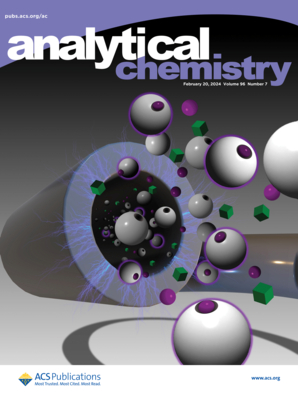Quantitative Detection of Pyrazines in Edible Oils Using SABRE Hyperpolarized NMR Spectroscopy.
IF 6.7
1区 化学
Q1 CHEMISTRY, ANALYTICAL
引用次数: 0
Abstract
Pyrazines are key flavor compounds in various foods, and their detection is essential for assessing quality, authenticity, and potential adulteration. However, because food matrices are complex mixtures, detecting pyrazines typically requires complex pretreatment steps to eliminate interference from structurally similar molecules. In this study, we present a highly selective detection method for pyrazines in food using sensitive and quantitative hyperpolarized NMR. Trace pyrazine compounds in edible oils were detected on a benchtop NMR system (60 MHz, 1.4 T) utilizing signal amplification by reversible exchange (SABRE) hyperpolarization through cosubstrate strategy. Thanks to the high selectivity of SABRE toward pyrazines, our method requires only a simple extraction procedure to achieve accurate quantification of pyrazine with the concentration of 59.3 μmol/L in sesame oil, and the limit of quantification is as low as 21.0 μmol/L. Compared to conventional high-field NMR (500 MHz, 11.7 T), our approach demonstrates high sensitivity and accuracy on a low-field NMR spectrometer. Our works validate SABRE as a powerful tool for highly selective trace analysis, with potential applications in food quality assessment, flavor profiling, and bioactivity analysis.SABRE超极化核磁共振光谱法定量检测食用油中的吡嗪类。
吡嗪是各种食品中重要的风味化合物,其检测对评估食品质量、真实性和潜在掺假至关重要。然而,由于食物基质是复杂的混合物,检测吡嗪通常需要复杂的预处理步骤,以消除结构相似分子的干扰。在这项研究中,我们提出了一种高选择性的食品中吡嗪的检测方法,该方法使用灵敏和定量的超极化核磁共振。在台式核磁共振系统(60 MHz, 1.4 T)上,通过共底物策略,利用可逆交换(SABRE)超极化放大信号,检测食用油中痕量吡嗪类化合物。由于SABRE对吡嗪具有较高的选择性,本方法仅需简单的提取步骤,即可准确定量测定香油中浓度为59.3 μmol/L的吡嗪,定量限低至21.0 μmol/L。与传统的高场核磁共振(500 MHz, 11.7 T)相比,我们的方法在低场核磁共振光谱仪上具有较高的灵敏度和精度。我们的工作验证了SABRE作为高选择性痕量分析的强大工具,在食品质量评估,风味分析和生物活性分析方面具有潜在的应用前景。
本文章由计算机程序翻译,如有差异,请以英文原文为准。
求助全文
约1分钟内获得全文
求助全文
来源期刊

Analytical Chemistry
化学-分析化学
CiteScore
12.10
自引率
12.20%
发文量
1949
审稿时长
1.4 months
期刊介绍:
Analytical Chemistry, a peer-reviewed research journal, focuses on disseminating new and original knowledge across all branches of analytical chemistry. Fundamental articles may explore general principles of chemical measurement science and need not directly address existing or potential analytical methodology. They can be entirely theoretical or report experimental results. Contributions may cover various phases of analytical operations, including sampling, bioanalysis, electrochemistry, mass spectrometry, microscale and nanoscale systems, environmental analysis, separations, spectroscopy, chemical reactions and selectivity, instrumentation, imaging, surface analysis, and data processing. Papers discussing known analytical methods should present a significant, original application of the method, a notable improvement, or results on an important analyte.
 求助内容:
求助内容: 应助结果提醒方式:
应助结果提醒方式:


